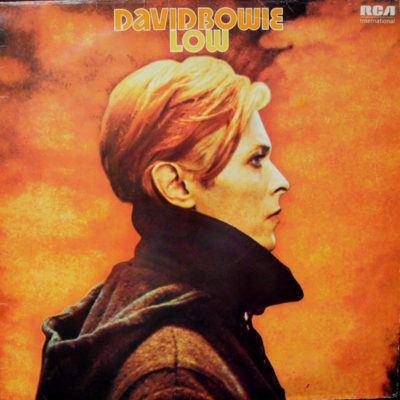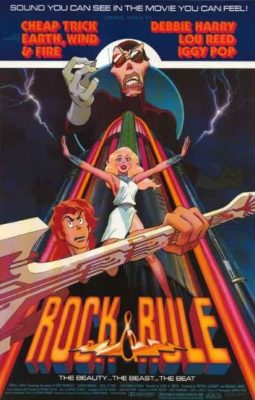Keeping up with the Jones. After an artistically creative and personally devastating period in LA (full-cream milk, red peppers, and cocaine are a balanced diet, right?), Bowie went into hiding in Europe. Low is meant to meant to suggest “keeping a low profile”. He failed. Keeping a low profile would necessitate a bad album, and Low is simply unforgettable.
They “There’s old wave, there’s new wave, and there’s David Bowie” In a record store, they might say “there’s David Bowie, then there’s Low”. Nomimally the first of the so-caled “Berlin Trilogy” (despite parts of it being recorded in France), Low doesn’t quite sound like anything else he’s done.
Side A has songs, bending punk rock, art rock, . Bowie has seldom written better songs, and Eno’s technical wizardry makes the music seem otherwordly. This is most noticeable on “Speed of Life”, which has varispeeded delay that sounds like strobing flashes of light hitting the Hubble telescope from a distant cosmic object.
The songwriting is sparse and free. Entire songs are threaded together with simple ingredients: a single hook, or rhythm, or texture, but are all the more impactful for it. Lead single “Sound and Vision” has no words until the halfway point, and they’re just minimalistic automatism. No references to the Kabbalah or homosexuality. Just Bowie looking at blue light through his window, waiting for ideas.
“Be My Wife” surprises with familiarity, jarring you with a conventional verse/chorus pop song. Bowie was so good at being fake that there’s often a creepy, uncomfortable sense that he’s dropping the mask and momentarily sharing real feelings, knowing that nobody would ever know. The harmonica-driven instrumental “A New Career in a New Town” spins away the remaining grooves much as “Speed of Life” began them: in adventurous fashion.
Side A is an amazing achievement for Bowie, for Eno, and for rock. It is also Low’s worst side.
Side B deeply, profoundly well-realised, a haunting exploration of sound. It’s ambient music made jagged and broken, like a priceless Qianlong Vase smashed on the floor, allowing the viewer to find whatever beauty they may in the fragments.
People often refer to it as “the instrumental side”, which isn’t right, as only “Art Decade” lacks lyrics and vocals. But they’re brilliant, unforgettable pieces of music, and showcases just how much atmosphere Brian Eno could evoke with tape loops and a one-finger melody.
The dominant ambient piece is “Warszawa”, evoking a city of rust and memories, ancient fumes pouring from its skin. Futuristic Minimoog lines counterpoint church bells and religious chanting in a strange, brutal language from another world. It’s six minutes long: hermetic, cthonic, and almost impenetrable upon first listen. You have to peel it back like a palimpsest, and I’m still not sure I fully get it. David Bowie used to play this live. As a set opener, no less.
“Warszawa” was written by a four year old. Well, the first three notes, anyway. David needed to attend court to square away some matters from the Los Angeles fiasco, leaving Brian Eno to try and come up with something. Tony Visconti’s four year old son wandered into the studio, discovered the piano, and plonked out three notes – an A, a B, and a C. Suddenly inspired, Brian Eno dashed to the boy’s side and completed the melody. I don’t see Visconti’s son credited in the album booklet. The tyke should sue.
The album’s remaining pieces gently come down from this crescendo. “Art Decade” is chilly and still, its melodic ideas frozen like images under glass. “Weeping Wall” has very busy instrumentation, its elements sometimes clashing and other times working in harmony. “Subterraneans” is deep, slow, and forbidding. If the album was a day, this would be the deepest watch of the night.
There’s bonus tracks, too, if you get the right version of the album. “Some Are” seems like a marriage of the two halves of the album, while “All Saints” is extremely harsh – industrial ambient rock as corrosive as drain cleaner. I’ve heard rumors that “All Saints” was recorded a long time after Low, and indeed, it sounds very different in its production approach. You get a remixed version of “Sound and Vision”, which belongs in a bin.
No Comments »
You’ve heard about this, or will: James Gunn was dismissed from the production of Guardians of the Galaxy 3.
First, condolences. I don’t often talk about this, but I was fired from a multi-million dollar movie production too. To get technical, I was “fired” in the sense of never being hired for one, but still, the wound is fresh.
What led to his firing? Some tweets, years old. Some are innocent, their context snipped away by sélecteur Mike Cernovich (a far right figure who apparently wanted Gunn fired). A couple were clearly jokes.
This scandal has provoked opinions, most of them bad. So far, nearly everything I’ve read about the firing of James Gunn is united in missing the mark.
“Why joke about that sort of stuff?” Why not joke about it? People joke about all manner of things. “It’s offensive!” Thank you, @JudenGrinderPepe1488, for being the voice of moral guidance we sorely need. “It trivializes pedophilia!” No, it doesn’t, dumbshit. It’s transgressive humor, which means it relies on shock and outrage. If pedophilia is trivial, the joke does not work.
I realise that many people don’t find Gunn’s humor funny, and don’t comprehend how anyone could. Let me attempt an explanation: when you joke about pedophilia, the goal is not to get a laugh but to provoke a shocked “ew!” response in your audience, which is isomorphic to humor in the minds of some people. In the same way, people eat chili peppers, not because capsaicinoids taste great, but because the burning sensation on your tongue is pleasurable. Maybe you don’t find it funny. This is because you’re trying to read a language without the necessary vocabulary. I think jazz is unlistenable, but this isn’t jazz’s fault: I’ve been trained to process music in certain ways that, unfortunately, have welded my brain shut to Miles Davis and Thelonious Monk. Your sense of humor was shaped by things, too, and when you judge something as unfunny, it judges you back.
You should still understand that firing people for jokes is wrong. After all, someday a person with power won’t understand one of your jokes.
But there’s an even more annoying sentiment being expressed, mostly from the political left. They are attempting to finesse some sort of culture war story where where unprincipled right wing conservatives are getting leftists fired in bad faith, something that would never happen in reverese because only the left has standards and decency and honor and (heavy breathing commences).
This narrative collapses under five minutes of investigation, but that isn’t the point. Cernovich did not fire Gunn. He does not own Disney, is not on their board of directors, and has no power over them whatsoever.
Disney fired Gunn.
Twitter’s remedy is “don’t pay attention to trolls like Cernovich”, which isn’t a solution at all. Bad faith actors are everywhere, and someone else will pull the same stunt tomorrow. Playing whack a mole with individuals is a waste of time in an ecosystem this vast: and Gunn-esque firings will continue to happen until we think systemically.
This requires a sidetrack into another topic: computer viruses.
In my lifetime, I have seen an interesting shift in who we blame for viruses on the internet.
In the 90s, we blamed the creator of the virus. When your computer got infected, you felt personally slighted, as if hax0rkid69 did the equivalent of leaving a bag of flaming shit on your front porch.
In the 00s, a shift happened, and we blamed the user. It was grandma’s fault for not recognizing that the .jpg had a hidden .exe at the end of it. Partly it was the fact that the era of personal “you got pwned by hax0rkid69!” attacks were over. Viruses relatively bland and anonymous, as if they’d achieved sentience and were programming themselves, and most had goals of marketing or theft rather than blind destruction. Mostly, it was learned helplessness. There were so many that trying to drop the hammer on individual virus creators was futile. The only way to stop them was for grandma to learn how to use her damned computer.
But in the 2010s, another shift happened. Nobody blames virus creators, or grandma. Just as we accept that viruses exist and will never go away, we also accept that incompetent users exist and will never go away. If your defense model relies on everyone exhibiting pluperfect competence, you have failed as a security engineer.
Now, we blame the system.
Scott Alexander recently commented that Apple’s MacOS contains an autocorrect that works on medical terms (such as changing “duloxetine” to “fluoxetine”). Apple fans arrived to point out that this can be very easily switched off…and the backlash was amazing, and inspiring. It’s not the responsibility of several million end users to navigate around Apple’s potentially life-threatening incompetence. The responsibility rests with the creators of the system. What makes more sense, solving a problem in O(n) or O(1) time?
This is an evolution of thought that should be applied to bad-faith actors getting their political opponents fired. Blaming Cernovich is bass-ackwards – the equivalent of getting mad at a script kiddie who infected your computer. Blaming Gunn is equally counterproductive. He would still have his job if he hadn’t sent those tweets, but he couldn’t have known those tweets would cost him his job when he sent them, just as grandma can’t reasonably be expected to check her emails for .exe attachments. Additionally, “those tweets were unacceptable but James Gunn deserves a second chance!” is a subcategory of “blaming Gunn”.
The only people handling this correctly are the ones blaming the big mouse.
Gunn had the misfortune to work in a system that is both increasingly risk averse and sensitive to PR scandals. This isn’t unreasonable: PR scandals are one of the few things a big corporation cannot control. Fortunately, there’s a ready solution: make it so that firing people for Twitter jokes leads to an even bigger PR scandal. That’s a risk companies need to be even more averse to.
No Comments »
This is a 1983 Canadian post-apocalyptic science fiction fantasy musical adult* cyberpunk neo-noir animated furry i hope i die
The plot is incidental (and embarrassing); cartoon mice save the world through the power of rock. It’s based on a 1978 Nelvana TV special called The Devil and Daniel Mouse, but updated to be edgy and dark and very, very serious. The songs are pretty thin, and guitars are wielded more often as weapons than as instruments.
But there are good moments, too. Some nice animation, and occasionally great character design. I say “occasionally” because it partakes in animation’s most onerous trend: Humans with Dog Noses. Who started the HWDN craze? Carl Banks? The Beagle Boys were obviously cartoony, but here we have straight-up humans with dog noses. It looks ridiculous, and immediately deep-sixes the edgy, dark, serious premise.
Dog noses are the first of many questionable artistic choices. The supporting characters are drawn like funny animals, but the lead characters are drawn realistically. They don’t seem to exist in the same world, and when whenever a lead and a support stands together the sharp disjunct between the two styles is all you can focus on.
My favorite part of the movie is everyone’s favorite part: the villain Mok. He steals the show with one of the most innovative character designs I’ve ever seen in an animated movie: a pastiche of Mick Jagger, Lou Reed, and Thin White Duke-era David Bowie. His face is an unimaginably complex manifold of vertices and angles, blending the feminine and masculine (and canine, but I’ve made my point), and the animators deserve kudos for keeping his ridiculousness on model. The movie suffers greatly whenever Mok’s not on screen, although there are fun computer-generated visuals and Debbie Harry does the best job she can.
The story in brief and in full: Mok (“the only Ohmtown rocker to go gold, platinum, and plutonium in one day!”) is seeing his commercial success wane, and hatches a plan to summon a demon from hell so he can…I dunno. I seriously have no idea what he’s trying to do, but we never understood what David Bowie was trying to do in real life, so there you go.
He kidnaps the female singer from a shitty glam rock band, because only her voice can complete the satanic ritual. Her dislikeable male co-singer has to rescue her along with some bumbling comic relief characters, who are more like comic constipation. Mostly, the movie succeeds in making you groan and cringe, such as when we find out they’re playing at Carnage Hall in Nuke York.
Bootlegs credit the film to Ralph Bakshi, which is false, yet also true, because this sort of movie probably wouldn’t exist without him. The success of Wizards and Fritz the Cat ushered in a few brief years when studios gave a bit of rope to animated films that weren’t obviously for children.
The rope had apparently played out by 1983, and Rock & Rule feels tampered with. The Gibsonian cyberpunk atmosphere is leavened with moments of wacky slapstick that could have been spliced in from Goof Troop (they couldn’t, for chronological reasons, but the vibe is similar). In particular, Mok’s henchmen ride around on rollerskates, which might have been an effort to save money on animation. When your characters are on wheels, it doesn’t matter if they slide around on the frame.
If a studio meddled with Rock & Rule, this is understandable. The film is confused and hard to market, and I’m still not sure who it was for. But it didn’t make any money even with all the commercial compromises, so why did they even try? Go for broke on your crazy post apocalyptic rock musical furry whatever! I’m reminded of this exchange from Karate Kid:
“I’d get killed if I go down there!”
“Get killed anyway.”
* (“Adult” means two fully-clothed characters feeling each other up, implied drug use, a Satanic pentagram, some intense imagery, and one character calling another “dick nose”, which if true would still be an improvement over dog noses.)
No Comments »



